Introduction
Overview of the Royal Poinciana Flame Tree Bonsai (Delonix regia)
The flame tree bonsai is no ordinary plant. It’s like the superstar of the bonsai world. Originating from Madagascar, this little guy has made its way into the hearts and homes of many plant enthusiasts worldwide. But what makes it so special, you ask?
Unique Characteristics and Aesthetic Appeal
- Vibrant Colors: The flame tree bonsai is named for its fiery red-orange flowers which burst into bloom, creating an impression of a tree on fire. Now, isn’t that something?
- Feathery Foliage: Beyond its flowers, this bonsai is known for its delicate, fern-like leaves adding a touch of elegance to its overall appearance.
- Year-round Attraction: While many bonsais are admired for their structure, the flame tree bonsai keeps the show going all year round with its evergreen nature.
- Size & Shape: With proper care, this bonsai can grow up to 5 feet tall. Its umbrella-like shape provides a unique silhouette compared to other bonsai trees.
- Easy Care: Last but not least, the flame tree bonsai isn’t too picky. It loves sun and doesn’t mind the occasional dry spell, making it a good fit for beginners and seasoned gardeners alike.
Now, that’s a lot of character packed into one small tree, isn’t it? Stay tuned as we delve deeper into the world of the flame tree bonsai in the sections to come!
The History and Origin of Flame Tree Bonsai
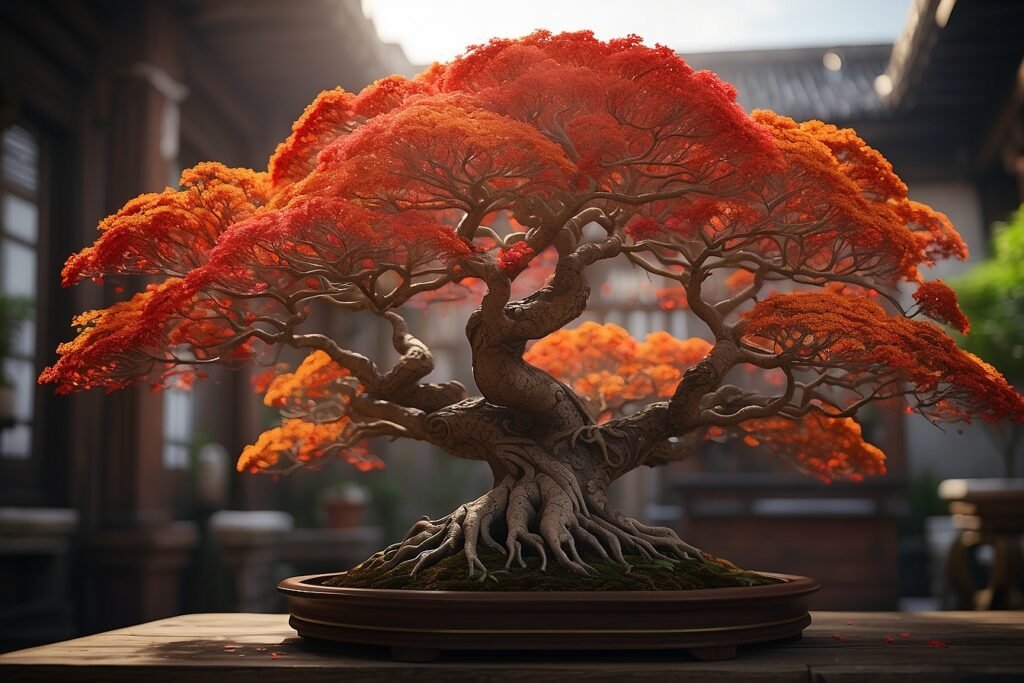
The Native Habitat of the Flame Tree
Hey, let’s go on a little journey, shall we? Picture this: Madagascar, a tropical paradise off the southeastern coast of Africa. This is where our star, the flame tree, originally comes from.
In its natural habitat, the flame tree isn’t just a cute little bonsai. Nope, it’s a full-blown, awe-inspiring tree that can reach up to 60 feet tall! Its fiery flowers and delicate leaves make it a real head-turner.
Here’s a snapshot of its natural habitat:
| Habitat Features | Flame Tree Characteristics |
|---|---|
| Climate | Tropical, enjoys full sun |
| Geography | Native to Madagascar, an island off the southeastern coast of Africa |
| Size in Wild | Can grow up to 60 feet tall |
| Appearance | Known for its vibrant red-orange flowers and feathery, fern-like leaves |
Journey from Madagascar to Becoming a Favored Bonsai Species
So, how did this giant, fiery tree from Madagascar become a small, beloved bonsai across the globe? Well, my friend, it’s all thanks to the ancient art of bonsai.
Originating in China and later spreading to Japan, bonsai is all about capturing the grandeur of nature in miniature form. When bonsai artists laid their eyes on the flame tree, they couldn’t resist its vibrant colors and unique shape. They knew they had to bring its beauty into the bonsai world.
Transforming this towering tree into a petite bonsai was no easy feat. But with patience and skill, they were able to create a smaller version that still carried all the charm of the original flame tree. And voila! The flame tree bonsai was born!
Today, whether you’re a seasoned bonsai veteran or a newbie, the flame tree bonsai is a favorite. Its striking appearance and manageable care make it a great addition to any collection.
And that’s the story of how our fiery friend traveled from the wild landscapes of Madagascar to our living rooms!
Growing Flame Tree Bonsai from Seeds
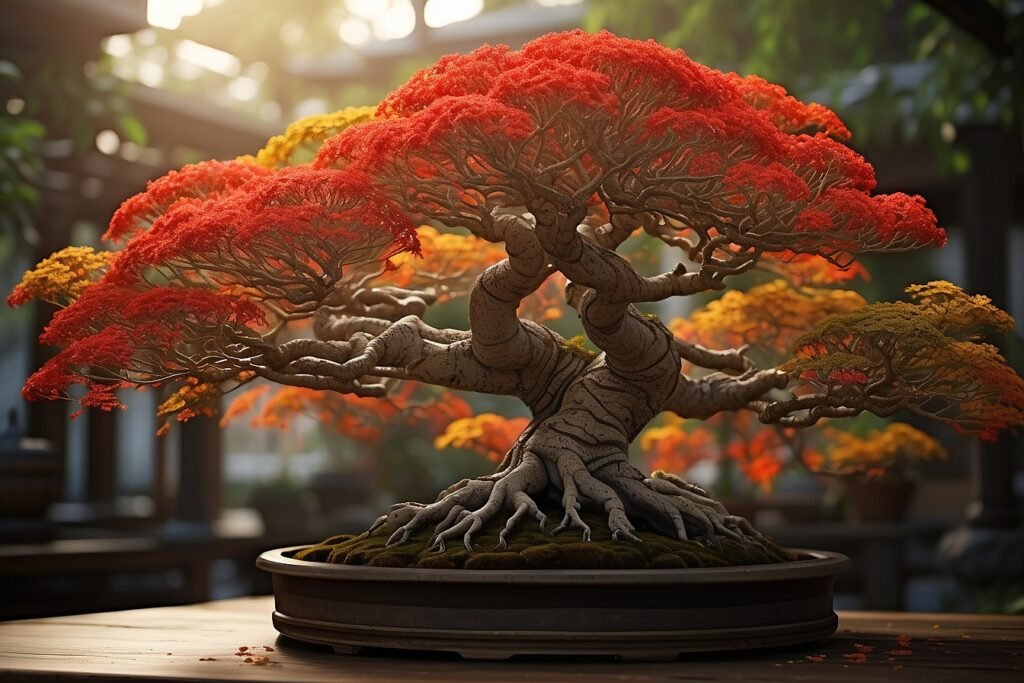
Detailed Steps on How to Grow a Flame Tree Bonsai from Seeds
So, you’ve fallen in love with the flame tree bonsai and want to grow one from scratch? Fantastic! Let’s get started:
- Seed Selection: Start by selecting high-quality seeds. This is the foundation of your future bonsai, so it’s worth investing time in finding the best ones.
- Soak the Seeds: Soak your seeds in hot water – about 50°C – for 24 hours. This helps to soften the seed coat and encourages germination.
- Sowing: After soaking, plant your seeds in soil. Cover them with about 1-2cm of soil.
- Keep It Moist: Make sure the soil stays moist but not overly wet. Overwatering can lead to root rot.
- Wait for Sprouting: With the right conditions, your seeds should sprout within 10 days.
- Transplanting: Once your seedlings reach about 8 inches high, it’s time to transplant them into a larger 1-gallon container.
The Ideal Conditions Required for Growth
Now that you know the steps, let’s talk about the ideal growing conditions:
- Temperature: The flame tree bonsai loves warmth, so keep it in a place where the temperature is consistently warm.
- Light: Full sunlight is best for this tropical beauty.
- Water: While the soil must stay moist, avoid overwatering.
- Soil: A well-draining soil mixture is crucial to prevent waterlogging and root rot.
Remember, patience is key when growing bonsai from seeds. But with time and care, you’ll have a beautiful flame tree bonsai to show off!
Care and Maintenance of Flame Tree Bonsai
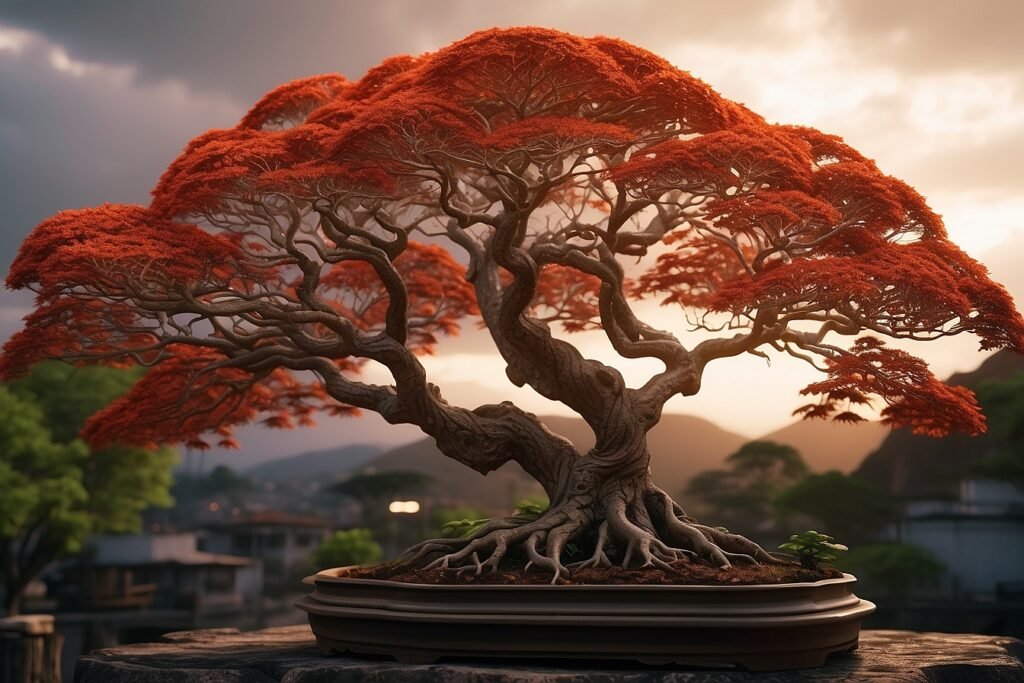
The Importance of Full Sun and Warm Temperatures
Just like us, the flame tree bonsai loves to bask in the sun, and it thrives in warm temperatures. So, if you want your bonsai to be happy, make sure it gets plenty of sunlight and warmth.
Remember, this little tree hails from Madagascar, a tropical paradise, so it’s used to soaking up the rays! Keep it in a sunny spot, ideally where it can get at least 6 hours of direct sunlight each day.
As for temperature, aim for around 20-28°C (68-82°F). Lower temperatures might slow down its growth, so keep it cozy!
Pruning and Shaping Techniques to Enhance Its Beauty
Pruning and shaping are the heart of bonsai artistry. They help to maintain the tree’s miniature size and enhance its aesthetic appeal. Here are some tips:
- Pruning: Regularly trim back the new growth to maintain the tree’s shape. The best time to prune is during the growing season.
- Shaping: Wire the branches when they are young and flexible to guide their growth. Be careful not to damage the bark.
- Defoliation: You can also try defoliation (removing leaves) to encourage smaller, denser foliage.
Watering, Feeding, and Repotting Guidelines
Watering, feeding, and repotting are crucial for your bonsai’s health:
- Watering: Keep the soil moist, but avoid overwatering. Check the soil regularly – if the top layer feels dry, it’s time to water.
- Feeding: Use a balanced bonsai fertilizer during the growing season to provide essential nutrients.
- Repotting: Repot your flame tree bonsai every 2-3 years to refresh the soil and give the roots room to grow. The best time to repot is in early spring.
And there you have it! With a bit of care and attention, your flame tree bonsai will reward you with its stunning beauty for many years to come!
Troubleshooting Common Problems
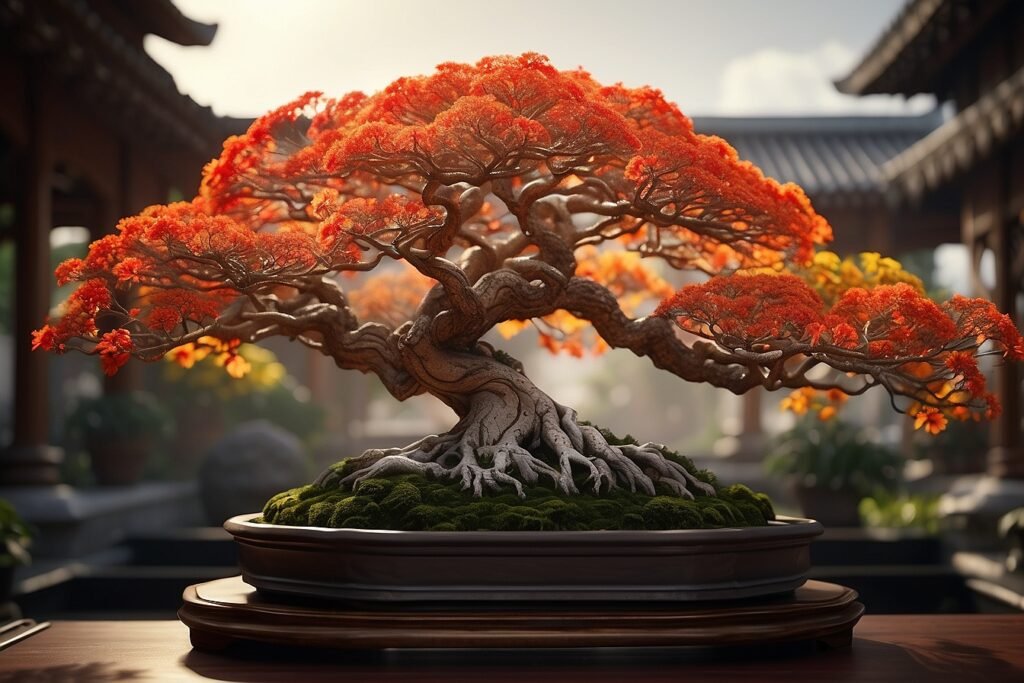
Identifying and Addressing Common Issues with Flame Tree Bonsai
Even with the best care, your flame tree bonsai may encounter a few bumps along the way. But no worries, we’ve got you covered:
- Yellowing Leaves: This could be a sign of overwatering or poor drainage. Check your watering routine and ensure your pot has sufficient drainage.
- Dropping Leaves: If your bonsai is dropping leaves, it might not be getting enough light. Remember, this sun-loving plant needs plenty of direct sunlight.
- Wilting or Soft Stems: This could indicate root rot, often caused by overwatering or poor soil drainage. You may need to repot the plant with fresh, well-draining soil.
- Pests: Keep an eye out for common pests like aphids and spider mites. If you spot any, treat the plant with a gentle insecticidal soap.
Tips for Keeping Your Bonsai Healthy and Vibrant
Keeping your flame tree bonsai healthy and vibrant is all about providing the right conditions and timely care:
- Sunlight: Give your bonsai plenty of sunlight. It thrives in full sun.
- Watering: Water only when the top layer of soil feels dry. Overwatering can lead to root rot.
- Feeding: Regularly feed your bonsai with a balanced fertilizer during the growing season.
- Pruning: Regular pruning helps maintain its miniature size and enhances its shape.
- Repotting: Repot every 2-3 years to refresh the soil and give the roots room to grow.
Remember, the key to a healthy bonsai is balance – balance in watering, feeding, and sunlight. With these tips, you’ll have a vibrant, thriving flame tree bonsai in no time!
Showcasing the Flame Tree Bonsai: Aesthetic Considerations
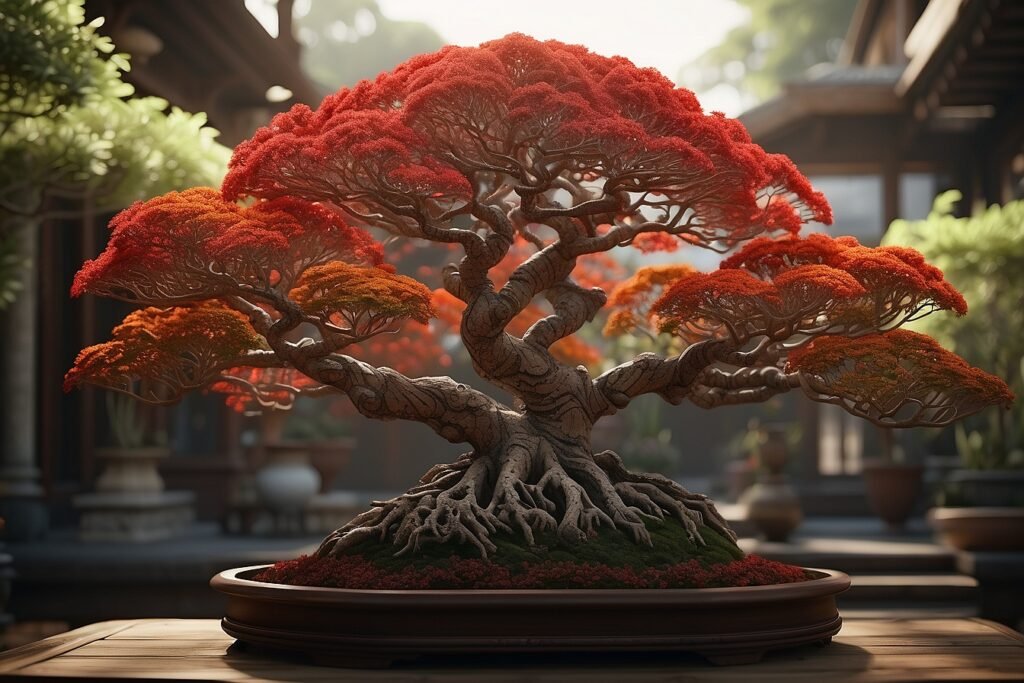
The Visual Impact of the Flame Tree Bonsai’s Fiery Flowers and Feathery Leaves
The flame tree bonsai is a true showstopper, with its fiery red flowers and feathery, fern-like leaves creating a stunning visual impact. When in bloom, the tree seems to be ablaze, hence the name “flame tree”.
The vibrant flowers contrast beautifully against the green leaves, creating an eye-catching display. Meanwhile, the delicate, fern-like leaves add a soft, delicate touch, balancing out the boldness of the blooms.
Ideal Display Settings and Pairings with Other Plants
When it comes to displaying your flame tree bonsai, consider these tips:
- Place of Pride: Given its vibrant colors and striking appearance, the flame tree bonsai deserves a prominent place where it can be fully appreciated. A sunny window sill, a well-lit study desk, or the center of a garden table are all great options.
- Pairing with Other Plants: If you’re displaying it outdoors, consider pairing it with other tropical plants that can tolerate similar light and temperature conditions. For indoor displays, consider pairing it with succulents, orchids, or other bonsais for a mini indoor garden.
- Pot Selection: Choose a pot that complements the tree’s fiery colors. Earthy tones like brown or terracotta can create a beautiful contrast, while a simple white pot can let the tree’s colors really pop.
- Seasonal Displays: Consider changing the surroundings according to the season. For instance, in autumn, you could surround it with fall foliage; in winter, some twinkling fairy lights could add a festive touch.
Remember, showcasing your flame tree bonsai is all about creativity. So feel free to experiment and find the perfect spot that highlights its fiery beauty!
Conclusion
Recap of the Rewarding Experience of Growing and Caring for a Flame Tree Bonsai
Growing and caring for a flame tree bonsai is indeed a rewarding experience. From providing it with the right amount of sunlight and warmth, pruning and shaping it to enhance its beauty, to understanding its watering, feeding, and repotting needs – each step is a testament to your nurturing abilities.
The visual impact of its fiery flowers and feathery leaves, and the joy of finding the perfect display setting, all add to the charm of this endeavor. Even troubleshooting common problems brings satisfaction, as you learn more about this amazing little tree and help it thrive.
Encouragement for Readers to Embark on Their Own Bonsai Cultivation Journey
If you haven’t already embarked on your bonsai cultivation journey, we hope this guide inspires you to do so. Whether you’re a seasoned gardener or a complete beginner, cultivating a bonsai offers a unique opportunity to connect with nature and express your creativity.
Remember, every bonsai tells a story – a story of patience, care, and growth. And there’s nothing quite like the sense of achievement when you see your flame tree bonsai in full bloom, knowing that you’ve played a part in its journey.
So why wait? Embrace the art of bonsai cultivation and let the flame tree bonsai add a splash of fiery beauty to your life!
Frequently Asked Questions (FAQs)
How often should I water my flame tree bonsai?
It’s best to water your bonsai when the top layer of soil feels dry. The frequency could vary depending on the climate and humidity levels. Overwatering can lead to root rot, so it’s essential to maintain a balance.
My flame tree bonsai is losing leaves, what could be the reason?
If your bonsai is dropping leaves, it might not be getting enough light. The flame tree bonsai is a sun-loving plant and needs plenty of direct sunlight.
When and how should I fertilize my flame tree bonsai?
Regularly feed your bonsai with a balanced fertilizer during the growing season. It’s best to follow the instructions on the fertilizer packaging for optimal results.
How often does a flame tree bonsai need to be repotted?
It is recommended to report your flame tree bonsai every 2-3 years to refresh the soil and give the roots room to grow.
I found some pests on my bonsai. How should I treat it?
Common pests like aphids and spider mites can be treated with a gentle insecticidal soap. Remember to isolate the affected plant to prevent the spread of pests to other plants.
Further Reading and Resources
- Mastering the Art of Rocky Mountain Pine Bonsai: A Comprehensive Guide
- Cultivating Harmony: A Comprehensive Guide to Ming Aralia Bonsai
- The Ultimate Guide to Barbados Cherry Bonsai Care and Cultivation
- The Art and Care of Colorado Blue Spruce Bonsai: A Comprehensive Guide
- The Enchanting World of Wisteria Bonsai: A Comprehensive Care Guide
- Cultivating the Art of Bonsai Pepper Plants: A Comprehensive Guide





